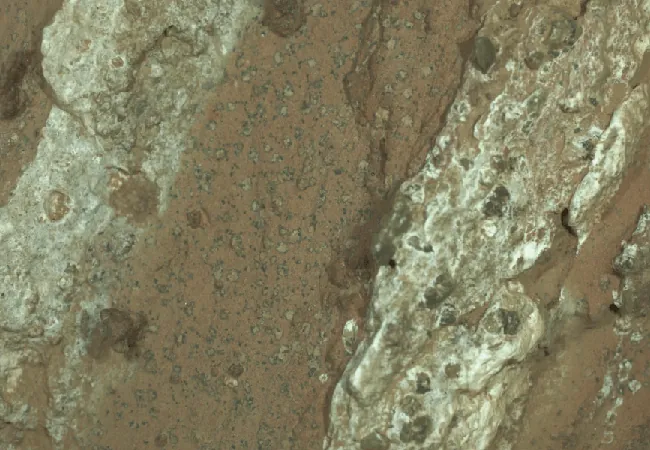
Is Mars Hiding Ancient Life? New Rock Findings Spark Excitement!
2025-09-22
Author: Daniel
Groundbreaking Discovery Suggests Past Life on Mars!
In a thrilling twist to the endless quest for extraterrestrial life, scientists have unveiled compelling evidence hinting at the existence of past microbial life on Mars. Acting NASA Administrator Sean Duffy proclaimed this revelation as "the closest we've ever come to discovering life on Mars!"
This exciting breakthrough emerged from the Perseverance rover's meticulous exploration of the Neretva Vallis, a long-dry riverbed spilling into the ancient Jezero Crater. Scientists had previously confirmed this crater harbored a lake, and the sedimentary rocks in the area are brimming with clay and silt—materials known to safely entrap signs of microbial life.
Colorful Spots: A Clue to Martian Microbes?
The Perseverance rover meticulously analyzed a rock stretching about 3.2 by 2.0 feet and discovered colorful spots that could indicate past microbial activity. These spots might be remnants of life, where microbes absorbed the rock's organic carbon, sulfur, and phosphorus for energy, leaving behind these striking chemical signatures. Recent findings published in the journal Nature on September 10 reveal that these markings likely correspond to elements commonly produced by microbes here on Earth.
Skepticism Remains: Could It Be Something Else?
While the colorful spots present an enticing possibility of ancient Martian life, scientists stress caution. They considered alternative explanations, such as intense heat or acidic conditions possibly creating these minerals. However, key evidence for acidic conditions remains absent, and some reactions could have occurred at lower, more favorable temperatures.
The Quest for Answers: Can We Confirm Life?
Given the myriad of potential explanations, the term "potential biosignatures" aptly summarizes these findings. To ascertain whether these colorful spots are indeed biological, researchers suggest further examination with tools currently only accessible on Earth. One of the Mars 2020 mission's main goals is to bring Martian rock samples back to Earth for in-depth analysis, although the Perseverance rover itself won’t return home.
Mars: The Water World?
This discovery is part of a broader effort to uncover if Mars ever supported life, focusing primarily on the search for water. Scientists now know that Mars once had flowing water, with frozen polar ice caps and additional ice hidden beneath the surface.
Over a century ago, astronomers misidentified features on Mars that were merely optical illusions, but in 2004, NASA confirmed water’s presence on the Martian surface when its Spirit and Opportunity rovers made significant discoveries within craters.
A History of Life on Mars?
In 2013, NASA's Curiosity rover examined ancient Martian rock, suggesting that a habitable environment for microbes once existed. The recent findings by Perseverance further add to the intriguing narrative surrounding the search for life's history on Mars.
Interestingly, the first Martian rock hinting at past life was discovered in 1984—a meteorite found in Antarctica containing minerals indicative of liquid water and microbial presence. However, meteorites found on Earth can undergo changes, potentially obscuring the telltale signs of Martian life.
The Reality Check: Are We Close to an Answer?
As with many scientific pursuits, the search for Martian life has been a rollercoaster of hope and skepticism. Many initial claims surrounding the 1984 meteorite were later challenged, leading scientists to conclude that not all clues were biological. The hunt for life on Mars remains fraught with uncertainty.
While the possibility of microbial life lingering beneath Mars' surface still exists, the journey continues as we seek definitive answers. Will this recent discovery be the breakthrough we've been waiting for, or will the cycle of questions and scrutiny persist? One thing is certain: the quest for Martian life is far from over!
 Brasil (PT)
Brasil (PT)
 Canada (EN)
Canada (EN)
 Chile (ES)
Chile (ES)
 Česko (CS)
Česko (CS)
 대한민국 (KO)
대한민국 (KO)
 España (ES)
España (ES)
 France (FR)
France (FR)
 Hong Kong (EN)
Hong Kong (EN)
 Italia (IT)
Italia (IT)
 日本 (JA)
日本 (JA)
 Magyarország (HU)
Magyarország (HU)
 Norge (NO)
Norge (NO)
 Polska (PL)
Polska (PL)
 Schweiz (DE)
Schweiz (DE)
 Singapore (EN)
Singapore (EN)
 Sverige (SV)
Sverige (SV)
 Suomi (FI)
Suomi (FI)
 Türkiye (TR)
Türkiye (TR)
 الإمارات العربية المتحدة (AR)
الإمارات العربية المتحدة (AR)